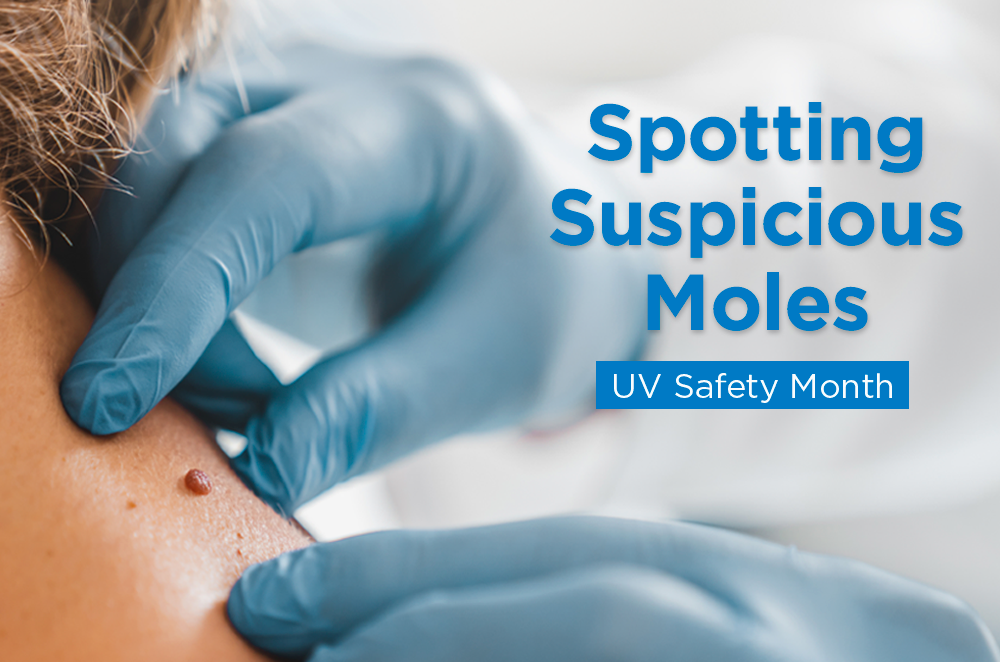As summer unfolds and we enjoy the sunshine, UV Safety Month reminds us to be mindful of our skin health. Moles are a common feature on our bodies, and understanding the difference between a normal mole and a potentially suspicious mole is a great step in safeguarding your well-being. We’re committed to empowering you with the knowledge to confidently monitor your skin and know when it’s time to seek professional advice.
What Do Normal Moles Look Like?
Most of us have moles, and the vast majority are harmless. Generally speaking, normal moles typically have the following characteristics:
Symmetry: They are usually round or oval in shape. If you draw a line through the middle, both halves would largely match.
Even Border: The edges are smooth and distinct, not blurry or ragged.
Consistent Color: They are usually a single shade of brown, tan, or black.
Small Diameter: Most normal moles are less than 6 millimeters (about the size of a pencil eraser).
Stable Appearance: They tend to look the same over time, without significant changes in size, shape, or color.
Knowing these characteristics of normal moles helps you better identify suspicious moles that might deviate from this typical appearance.
The ABCDE’s of Skin Cancer
However, while normal moles are usually nothing to worry about, changes in moles or the appearance of new, unusual spots can be indicators of skin cancer. This is particularly true for melanoma, the most serious type. Consequently, it’s important to be aware of the following signs that can point to suspicious moles:
A – Asymmetry: One half of the mole does not match the other half.
B – Border Irregularity: The edges are ragged, notched, blurred, or irregular.
C – Color Variation: The mole has uneven color, with shades of brown, black, tan, white, red, or blue.
D – Diameter: The mole is larger than 6 millimeters (the size of a pencil eraser). While harmless moles can be larger, nonetheless, this is a warning sign.
E – Evolving: The mole is changing in size, shape, color, or elevation, or is showing new symptoms like bleeding, itching, or crusting.
Common Myths About Moles
When it comes to moles and skin health, there’s a lot of information out there, and not all of it is accurate. Misconceptions can lead to unnecessary worry or, conversely, a false sense of security regarding suspicious moles. To help you better understand your skin and protect yourself, let’s debunk some common myths surrounding moles and skin cancer. Knowing the facts can make all the difference in recognizing potential issues early.
- Myth: Only people with fair skin get skin cancer.
- Fact: While fair-skinned individuals are at higher risk, skin cancer can affect anyone, regardless of skin tone. UV exposure is a risk factor for everyone.
- Myth: Moles that are raised are always cancerous.
- Fact: Many benign moles are raised. Instead, the key is to look for the ABCDE characteristics, not just elevation.
- Myth: Only new moles can be cancerous.
- Fact: Skin cancer can develop in existing moles or appear as new lesions. For this reason, the “E” for Evolving is so important.
- Myth: If a mole doesn’t hurt, it’s not dangerous.
- Fact: Melanoma is often painless in its early stages. Indeed, pain or itching can be late signs.
Your Skin Health Action Plan
Knowledge about your skin is powerful, yet taking action is what truly makes a difference. To effectively track your moles, regularly examine your skin, ideally once a month. We recommend taking photos of your moles to create a baseline; this makes it easier to spot any changes over time.
Be sure to pay special attention to sun-exposed areas and those hard-to-see spots, such as your back and scalp. If you notice any suspicious moles exhibiting the ABCDE signs, or if you have any other concerns about a spot on your skin, don’t hesitate to schedule an appointment with one of our board-certified dermatologists. Remember, early detection is crucial for successful skin cancer treatment.
Resources:
https://www.skincancer.org/early-detection/self-exams/
https://spottingcancer.org/cancer-signs-and-symptoms-skin-changes/
https://www.skincancer.org/skin-cancer-information/melanoma/melanoma-warning-signs-and-images/
Disclaimer:
The Comanche County Memorial Hospital website does not provide specific medical advice for individual cases. Comanche County Memorial Hospital does not endorse any medical or professional services obtained through information provided on this site, articles on the site, or any links on this site.
Use of the information obtained by the Comanche County Memorial Hospital website does not replace medical advice given by a qualified medical provider to meet the medical needs of our readers or others.
While content is frequently updated, medical information changes quickly. Information may be out of date, and/or contain inaccuracies or typographical errors. For questions or concerns, please contact us at contact@ccmhhealth.com.

